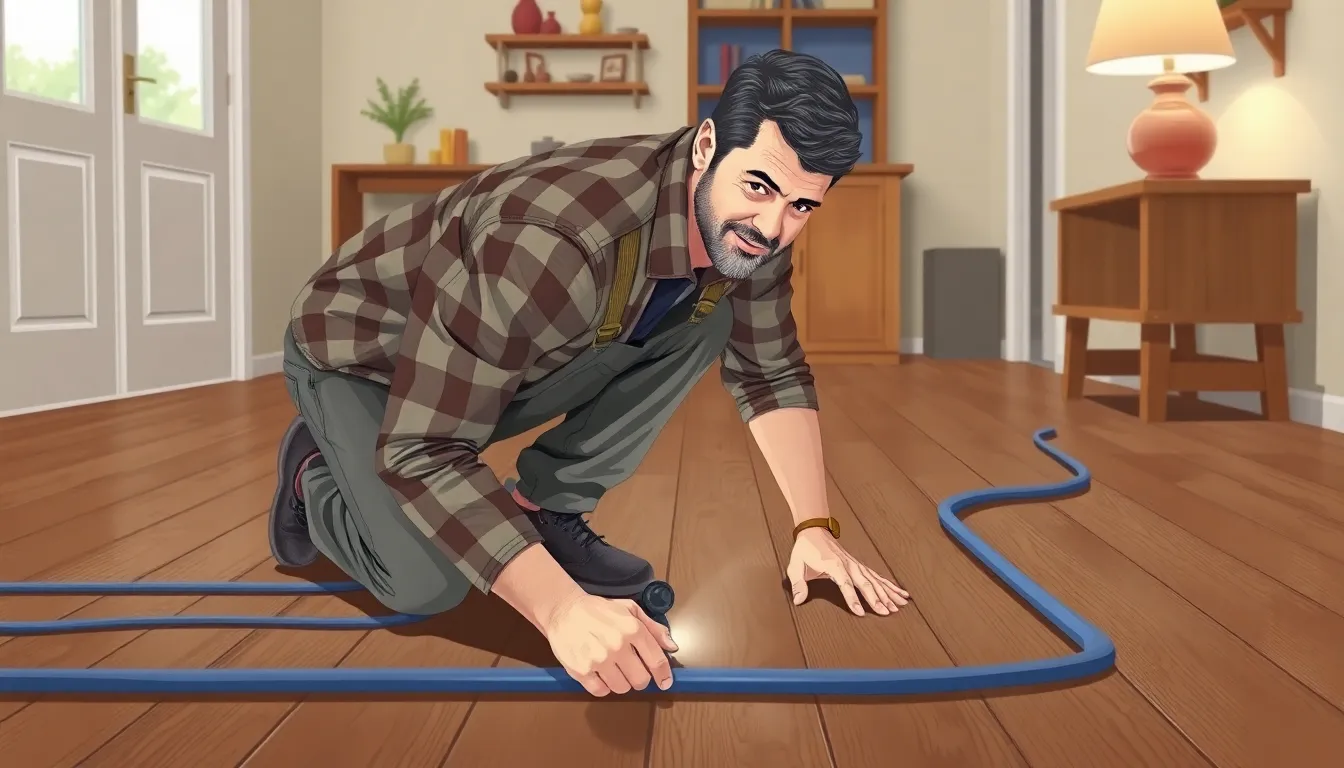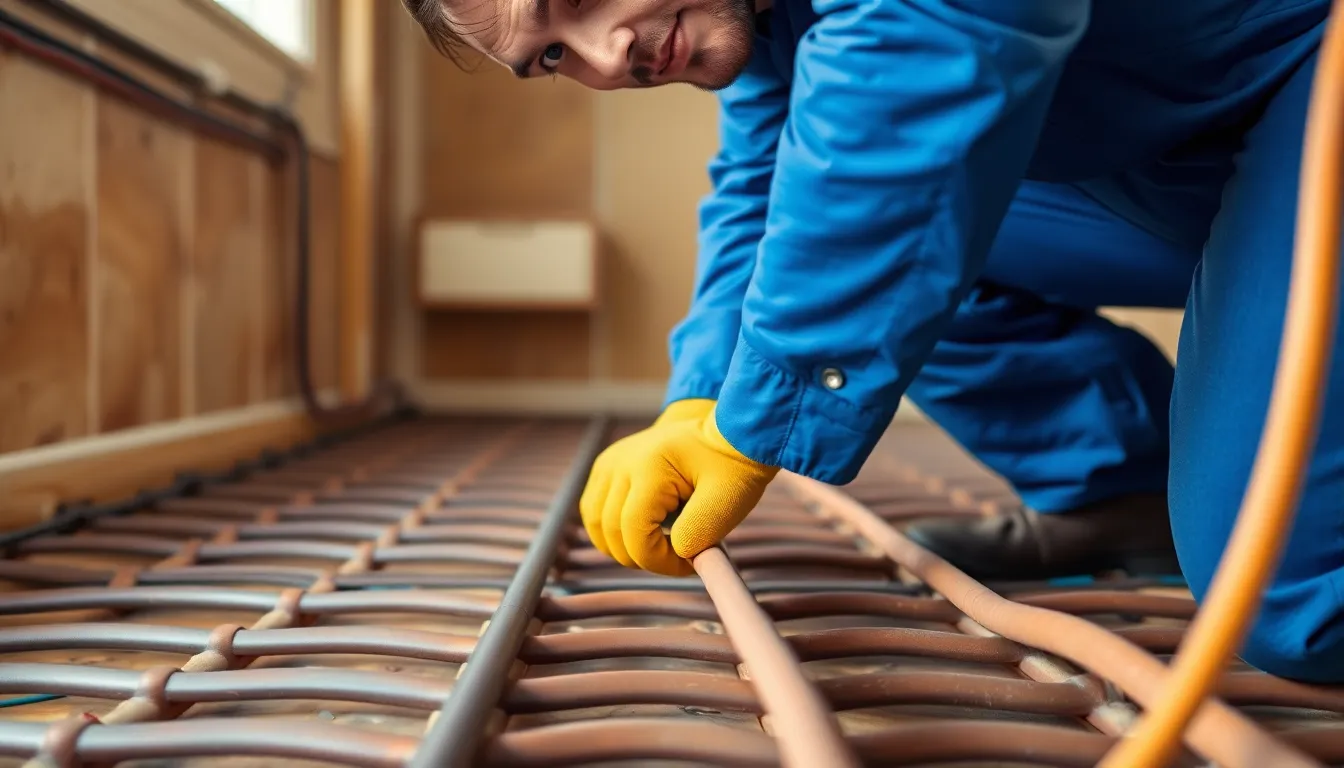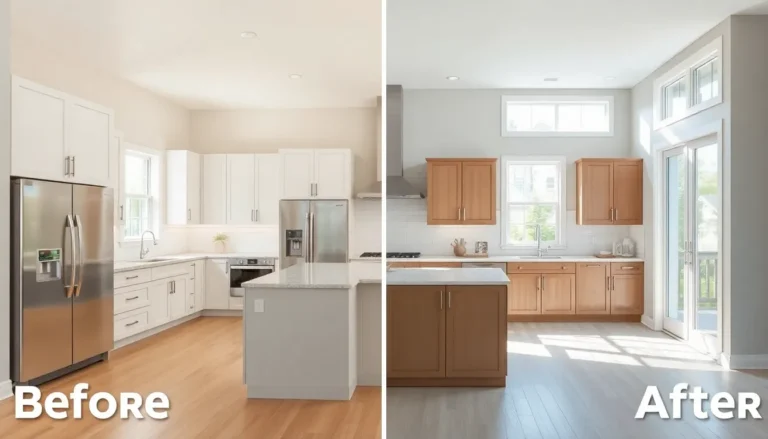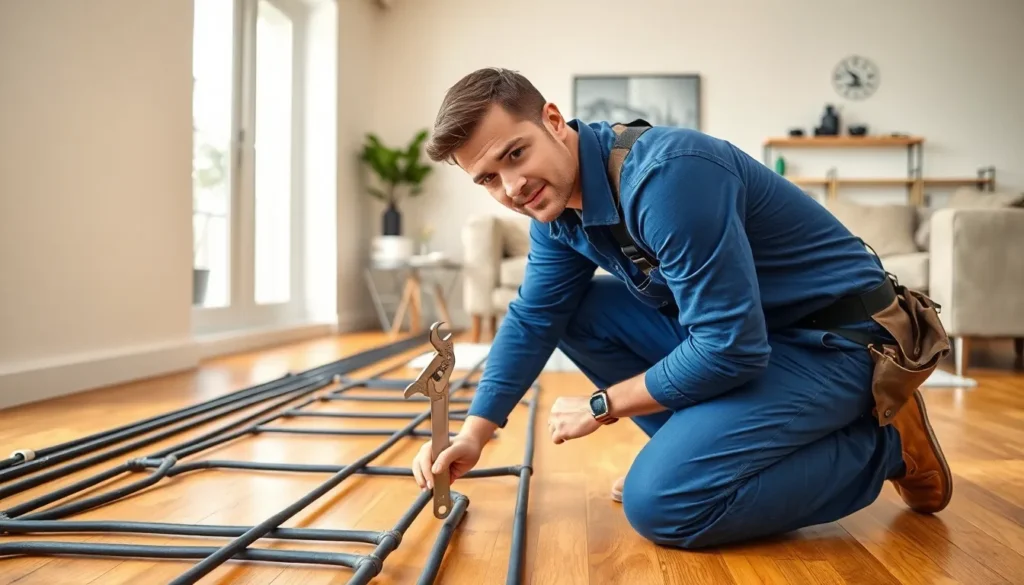Table of Contents
ToggleWhen winter rolls around and your toes start to resemble ice cubes, the last thing you want is a malfunctioning underfloor heating system. Imagine stepping onto your floor and feeling a chill that could rival the North Pole. Not exactly the cozy haven you envisioned, right? Underfloor heating repair might not sound like the most thrilling topic, but it’s essential for keeping your home warm and inviting.
Understanding Underfloor Heating Systems
Underfloor heating systems provide efficient and comfortable warmth indoors. Knowledge of their types and operation helps ensure effective maintenance and repair.
Types of Underfloor Heating
Electric and hydronic systems represent the main types of underfloor heating. Electric systems use heating cables or mats installed beneath floor coverings. Hydronic systems circulate hot water through pipes embedded in the floor. Both options offer different installation processes and energy efficiencies. Electric systems generally cost less to install but may incur higher energy bills in large spaces. Hydronic systems work well for larger areas, providing consistent heat distribution.
How Underfloor Heating Works
Heat distribution occurs through radiation in underfloor heating systems. Warm surfaces radiate warmth upwards, creating an even temperature throughout the room. Electric systems generate heat via wire coils or mats activated by a thermostat. Hydronic systems use a boiler to heat water that circulates through pipes. Effective temperature control allows both systems to maintain desired warmth efficiently. Insulation beneath the heating element enhances energy efficiency by minimizing heat loss.
Common Issues in Underfloor Heating


Underfloor heating systems may encounter various issues. Recognizing these problems early helps prevent further complications.
Leaks and Moisture Problems
Leaks pose a significant threat to underfloor heating systems. They can occur in hydronic setups where pipes, under pressure, may develop cracks or joints may fail. Moisture accumulation leads to decreased efficiency and potential damage to flooring materials. Homeowners should monitor for damp spots or water pooling on the floor. Regular inspection of pipe connections helps in identifying early signs of leaks. Timely repairs not only restore functionality but also protect the integrity of the home environment.
Thermostat Malfunctions
Thermostat malfunctions disrupt the control of underfloor heating systems. If the thermostat fails to signal heating elements properly, rooms may remain uncomfortably cold or excessively warm. Calibration issues or wiring problems are common causes. Signs of a malfunction include unpredictable temperature fluctuations or unresponsive controls. Regular testing and recalibration of thermostats help maintain effortless temperature management. Addressing these issues promptly ensures optimal performance and comfort in living spaces.
Diagnosing Underfloor Heating Problems
Diagnosing underfloor heating problems requires careful observation and the right tools. Recognizing the signs of failure early helps prevent more extensive damage.
Signs of Underfloor Heating Failure
Homeowners may notice cold spots on the floor, which indicate uneven heat distribution. Unusual noises, such as gurgling or hissing from hydronic systems, can suggest trapped air or leaks. They might also observe damp patches on the flooring, pointing to moisture issues or leaking pipes. Additionally, fluctuating temperatures, particularly in rooms with thermostats, can signify malfunction. Monitoring these signs leads to timely repairs and maintains a comfortable living space.
Tools for Diagnosis
Thermal imaging cameras provide valuable insights into temperature variations across the floor. They detect heat loss and help identify cold spots quickly. Manometers measure pressure within hydronic systems to pinpoint potential leaks or blockage issues. Multimeters enable homeowners to assess electrical elements in electric systems, ensuring they function correctly. Using these tools facilitates accurate diagnosis and minimizes repair time, ensuring efficient underfloor heating operation.
Underfloor Heating Repair Techniques
Effective repair techniques can restore the efficiency and comfort of an underfloor heating system. Various methods exist for addressing issues, depending on the system type and the specific problem encountered.
DIY Repair Options
Homeowners can tackle minor repairs with some basic tools and knowledge. Inspect visible components, including mats or cables, for damage, and look for damp patches that may indicate leaks. Utilizing a multimeter allows for testing electrical components, while manometers can measure pressure in hydronic systems. Replacing a broken thermostat is often straightforward; simply follow the manufacturer’s instructions. Before attempting repairs, always turn off the system to ensure safety. If problems persist, or if leakage is severe, exploring professional assistance becomes essential.
When to Call a Professional
Certain situations warrant contacting a professional technician. Signs of complex heating issues, such as persistent cold spots or unusual noises from hydronic systems, indicate underlying complications. Professionals possess specialized tools, like thermal imaging cameras, which can accurately identify hidden problems. Persistent leaks that damage flooring require expert assessment and repair. Hiring a professional also ensures compliance with safety regulations and effective resolution. When unsure about the severity of an issue, seeking expert guidance is the safest option to protect home comfort.
Preventive Maintenance for Underfloor Heating
Preventive maintenance ensures longevity and efficiency of underfloor heating systems. Regular upkeep plays a critical role in maintaining comfort during winter months.
Regular Inspections
Regular inspections help identify potential issues before they escalate. Homeowners should check for visible signs of wear, including cracks in flooring or signs of moisture intrusion. Inspecting thermostats promotes accurate temperature control, ensuring a consistent heating experience. Additionally, monitoring for unusual noises from hydronic systems offers insights into system health. Utilizing thermal imaging cameras can assist in detecting hidden heat loss. Addressing these concerns promptly limits costly repairs down the line.
Best Practices for Maintenance
Best practices for maintenance include routine cleaning and calibration of system components. Cleaning filters and ensuring that vents are unobstructed enhances airflow and efficiency. Calibrating thermostats at regular intervals guarantees optimal temperature regulation. Homeowners should also maintain proper insulation to minimize heat loss and improve energy efficiency. Scheduling annual professional inspections ensures thorough evaluation of complex system elements. Following these guidelines fosters reliable performance and extends the lifespan of underfloor heating systems.
Maintaining a well-functioning underfloor heating system is vital for comfort during colder months. Homeowners should prioritize early detection of issues to avoid costly repairs and ensure consistent warmth. Regular inspections and preventive maintenance can significantly enhance the system’s efficiency and longevity.
Whether tackling minor repairs or seeking professional assistance for complex problems, understanding the nuances of underfloor heating can lead to a more comfortable living environment. By staying proactive and informed, they can enjoy the benefits of a cozy home all winter long.






